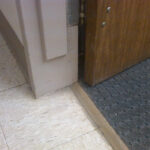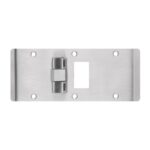The last week has been a tough one, and I apologize for any side effects that you may have noticed – either on iDigHardware or in my response time. Last Monday night, one of my oldest and dearest friends experienced the sudden and unexpected loss of her husband. Of course my first instinct was to drive across town to see how I could help – except that I live in another country now. I flew back for a quick trip to Massachusetts, and today I arrived in Carmel, Indiana for some meetings at our office there.
Because of this spontaneous travel, things got a little out of whack. First, it is Wednesday, and today’s Wordless Wednesday post is here. Second, we are working on the next series of whiteboard animation videos (the others are here), and I would be eternally grateful if anyone has time to give the draft scripts a once-over to see what I forgot to mention. Here’s the first one…
Introduction to Codes [Draft Script]
Building codes and fire codes help to ensure safety for building occupants. When codes are adopted in a jurisdiction, they become enforceable by law and can be used to hold people accountable in court when code violations result in injuries, fatalities, or property damage. In countries that do not have codes or officials to enforce them, fires and other incidents often result in a very high loss of life.
The first question when trying to research a code issue is – “Which code or standard applies to this project or facility?” There are building codes, fire codes, other codes, and several referenced standards that apply to door openings. Although most codes and standards are revised every 3 years, the newest edition may not be adopted in the project’s jurisdiction right away. The building code that is in effect when the building permit is issued is typically the code used during design and construction. The International Building Code, or IBC, has been adopted by many US states, but states will often modify the IBC and add state-specific requirements so it’s important to be familiar with those modifications.
Prior to 2000, there were 3 model building codes in the US – now called the Legacy Codes:
- BOCA National Building Code
- UBC Uniform Building Code
- SBCCI Standard Building Code
The organizations responsible for these codes worked together to form the International Code Council, or ICC, and to create the 2000 edition of the International Building Code. The IBC has been revised on a 3-year cycle since 2000. The National Fire Protection Association, or NFPA, is responsible for another building code – NFPA 5000 – The Building Construction and Safety Code. Many of the means of egress requirements in NFPA 5000 are consistent with NFPA 101 – The Life Safety Code.
When a building is complete, the fire marshal typically enforces a fire code throughout the life of the building. The International Fire Code, or IFC, and NFPA 1 are commonly-used fire codes in the US. The door-related requirements of NFPA 1 are also found in NFPA 101 – The Life Safety Code. Again, there may be state modifications to the fire code.
Each code also references many standards, which include more detailed information about a particular topic. For example, a state may have adopted the 2015 IBC with state modifications for use during design and construction, and adopt the 2012 editions of NFPA 1 and NFPA 101 as the fire code for occupied buildings. Each of these codes references a different edition of NFPA 80 – Standard for Fire Doors and Other Opening Protectives, so it’s important to know how the requirements vary from one code or standard to the next, and to apply the most stringent requirements.
As new products are developed and technology changes, the code development process is used to gather input from all of the stakeholders with an interest in addressing changes to the code. Proposals are submitted and reviewed and are then approved, disapproved, or modified by a technical committee. There is a public comment period where proposals can be discussed further and more modifications made. Individuals can submit a code change proposal, but working as a group can help to ensure that all aspects are studied. The Builders Hardware Manufacturers Association (BHMA) Codes and Government Affairs Committee, works together on changes to many code requirements that affect door openings.
You can usually determine which code is being used in a project’s jurisdiction by doing an online search for a particular state’s building code or fire code. Reed Construction Data maintains a site that includes the relevant codes and standards for each state, as well as contact information for the code officials. The Reed site can be accessed using the Codes tab on iDigHardware.com. The IBC or IFC Commentary and the NFPA 101 Handbook include additional information that helps to explain the code requirements. These publications are not legally binding, but are often used by Authorities Having Jurisdiction and design professionals to help them interpret the codes.
The term, “Authority Having Jurisdiction” is defined by the National Fire Protection Association as “An organization, office, or individual responsible for enforcing the requirements of a code or standard, or for approving equipment, materials, an installation, or a procedure.” The person responsible for enforcement or approval could be the building inspector, fire marshal, other code officials, an accreditation organization, or other type of inspector, and they may be enforcing different codes – another reason to be aware of the most stringent requirements.
There have been many tragic fires and other incidents that have shaped the codes and specifically impacted the door and hardware industry. Within minutes, more than 600 people were killed by a fire at the Iroquois Theater, largely because of the way the exits were arranged. This fire inspired the invention of the first panic hardware in 1908. The fire at the Triangle Shirtwaist factory killed 146 people because the workers were locked inside. This practice still occurs regularly in some countries. In the Cocoanut Grove fire, 492 people were killed, but fire officials testified that if the exits were available, unlocked and outswinging, then 300 of those lives could have been saved. Even though we now have strict codes and enforcement, these egress problems have not been fully resolved as we saw in the 2003 fire at the Station Nightclub in Rhode Island, where 100 people were killed and many injured.
Code requirements impact many aspects of door openings and can affect the selection of almost every hardware item. Which doors require panic hardware? What hardware must be used on a fire door? Where can delayed egress locks be used? Whether we’re specifying, supplying, installing, or inspecting doors and hardware, it’s our responsibility to speak up if we see situations that we know are not code-compliant and do our best to rectify them.
You need to login or register to bookmark/favorite this content.






Looks great!
The script looks good. I would suggest adding some of the accessibility codes into the section about different standards. There are significant differences not only between yearly editions but between ANSI 117.1 and the various ADA standards. IBC references ANSI, NFPA references both ADA and ANSI, so things get messy pretty fast.
Here is a link to an NFPA Journal article about the history of the 5000 building code. I’m not sure if it would be appropriate to include as a link after the video but it may be interesting to those following the blog.
http://www.nfpa.org/newsandpublications/nfpa-journal/2010/november-december-2010/features/nfpa-fire-and-life-safety-conference-preview-future-world/
Same thing with this link to a comparison between the 2006 IBC and NFPA 101.
http://www.wbdg.org/ccb/VA/VASTUDIES/codecomparison.pdf
Thanks Logan!
Hello Lori, I suggest that you add some words about this being the case in the US alone. Canadian codes are different and there are conflicts between IBC, NFPA 101 and the National Building Code of Canada (NBCC). Please note that building codes fall under provincial jurisdiction and the NBCC applies to federal property, Indian reservations or as enabled and modified by provincial legislation. Some provinces have their own codes based on the NBCC – Ontario and Alberta. I must admit that I have had people making comments to me about applying the IBC in many countries other than the US. The assumption was because it is called International it can be applied as such. My clarification has been to tell them to read the front pages about enabling legislation and so on. In Canada we have an interesting situation in that many of our codes do reference NFPA standards and other documents. Too many times I have seen blanket references to standards that are not applicable under our code structures – NFPA 101 and 70 being the worst culprits. Our approach has now been revised to reference the applicable Canadian building or fire code only as the code documents carry the correct and applicable references to the NFPA standards that actually apply. This seems to removes most of the confusion.
That’s a good point! Thanks John!